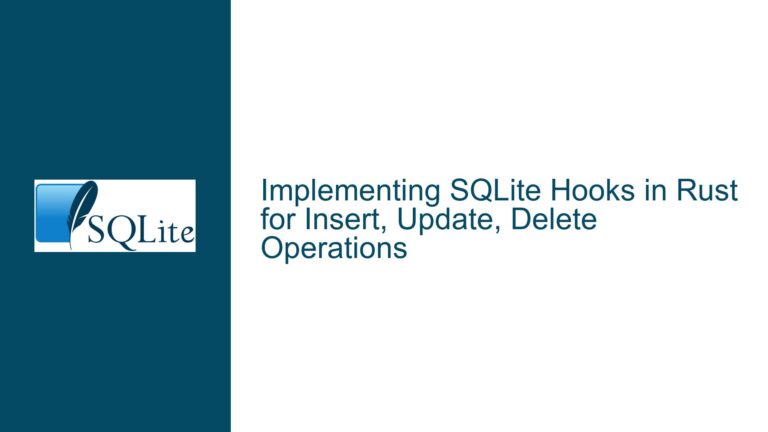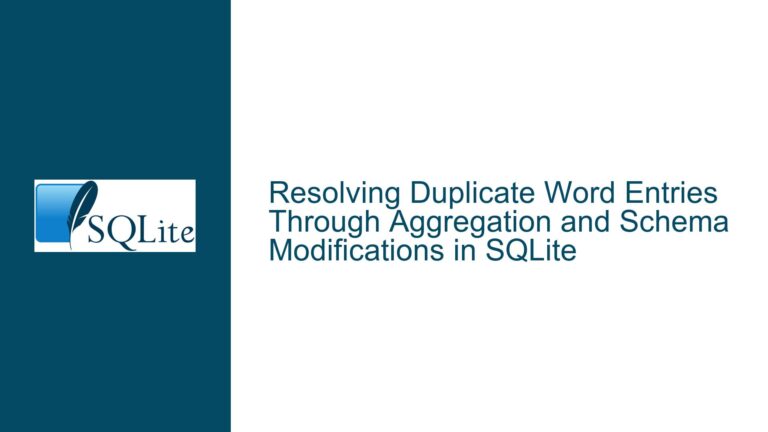Updating Records in SQLite Based on Selections from Another Table
Issue Overview: Updating Date Fields in Table B Based on Selections from Table A
In SQLite, updating records in one table based on selections from another table is a common task, especially when dealing with relational data. The core issue here involves updating date_field_2 in Table B with the value of date_field_1, but only for records that are associated with Table A where the status is ‘Confirmed’. The challenge arises because there is no explicit matching ID between Table A and Table B, which complicates the process of linking the two tables.
To understand the problem more deeply, let’s break down the components:
- Table A: Contains records with a
statusfield. Only records wherestatusis ‘Confirmed’ are relevant for this operation. - Table B: Contains two date fields,
date_field_1anddate_field_2. The goal is to updatedate_field_2with the value ofdate_field_1, but only for records that are somehow related to the ‘Confirmed’ records inTable A. - Lack of Direct Relationship: There is no explicit foreign key or matching ID between
Table AandTable B, which means we cannot directly join these tables using a common column.
This scenario is common in databases where relationships between tables are implicit rather than explicit. For example, Table A might represent orders, and Table B might represent shipments. The relationship between orders and shipments might be based on business logic rather than a direct foreign key relationship.
Possible Causes: Why the Update Operation Fails or Is Complex
The complexity of this operation arises from several factors:
Implicit Relationships: When tables are related implicitly (e.g., through business logic or application-level relationships), SQL queries must rely on more complex logic to establish these relationships. This often involves using subqueries, joins, or other advanced SQL techniques.
Lack of Foreign Keys: Foreign keys are used to enforce referential integrity between tables. When foreign keys are absent, the database cannot automatically enforce relationships, and the developer must manually ensure that the relationships are correctly established in queries.
Data Integrity Issues: If the data in
Table AandTable Bis not consistent (e.g., if there are missing or mismatched records), the update operation might fail or produce incorrect results. For example, if some ‘Confirmed’ records inTable Ado not have corresponding records inTable B, the update operation might skip these records or produce errors.Performance Considerations: When dealing with large datasets, the absence of indexes or efficient query design can lead to performance issues. For example, if
Table AandTable Bcontain millions of records, a poorly designed query might take a long time to execute or even time out.Ambiguity in Selection Criteria: Without a clear matching ID, the selection criteria for updating
date_field_2inTable Bmight be ambiguous. For example, if multiple records inTable Acould potentially match a single record inTable B, the query might need additional logic to resolve this ambiguity.
Troubleshooting Steps, Solutions & Fixes: How to Update Table B Based on Selections from Table A
To address the issue of updating date_field_2 in Table B based on selections from Table A, we need to follow a systematic approach. Below are the detailed steps, solutions, and fixes:
Step 1: Establish a Relationship Between Table A and Table B
Since there is no explicit matching ID between Table A and Table B, we need to determine how these tables are related. This might involve analyzing the data and identifying a common attribute or combination of attributes that can be used to link the tables.
For example, if Table A contains orders and Table B contains shipments, the relationship might be based on the order_id in Table A and the shipment_id in Table B. If such a relationship exists, we can use it to join the tables.
If no direct relationship exists, we might need to create a temporary table or view that establishes the relationship. For example, we could create a view that combines Table A and Table B based on a common attribute, such as a date range or a shared business key.
Step 2: Write a Query to Select the Relevant Records
Once the relationship between Table A and Table B is established, we can write a query to select the relevant records. This query should:
- Filter
Table Ato include only records wherestatusis ‘Confirmed’. - Join
Table AwithTable Bbased on the established relationship. - Select the records from
Table Bthat need to be updated.
For example, if we have established that Table A and Table B are related based on a common order_id, the query might look like this:
SELECT b.*
FROM TableA a
JOIN TableB b ON a.order_id = b.order_id
WHERE a.status = 'Confirmed';
This query selects all records from Table B that are associated with ‘Confirmed’ records in Table A.
Step 3: Write an Update Query to Modify date_field_2 in Table B
With the relevant records selected, we can now write an update query to modify date_field_2 in Table B. The update query should:
- Use the same join condition as the select query to ensure that only the relevant records are updated.
- Set
date_field_2to the value ofdate_field_1.
For example, the update query might look like this:
UPDATE TableB
SET date_field_2 = (
SELECT a.date_field_1
FROM TableA a
WHERE a.order_id = TableB.order_id
AND a.status = 'Confirmed'
)
WHERE EXISTS (
SELECT 1
FROM TableA a
WHERE a.order_id = TableB.order_id
AND a.status = 'Confirmed'
);
This query updates date_field_2 in Table B with the value of date_field_1 from Table A, but only for records that are associated with ‘Confirmed’ records in Table A.
Step 4: Test the Query on a Small Dataset
Before running the update query on the entire dataset, it is important to test it on a small subset of the data. This helps to ensure that the query works as expected and does not produce unintended results.
To test the query, we can use a SELECT statement with the same conditions as the UPDATE query. For example:
SELECT b.date_field_2, a.date_field_1
FROM TableB b
JOIN TableA a ON b.order_id = a.order_id
WHERE a.status = 'Confirmed';
This query shows the current value of date_field_2 in Table B and the value of date_field_1 from Table A for the relevant records. By comparing these values, we can verify that the update query will produce the desired results.
Step 5: Execute the Update Query
Once the query has been tested and verified, it can be executed on the entire dataset. It is important to ensure that the database is backed up before running the update query, as this operation cannot be easily undone.
To execute the update query, simply run the following command:
UPDATE TableB
SET date_field_2 = (
SELECT a.date_field_1
FROM TableA a
WHERE a.order_id = TableB.order_id
AND a.status = 'Confirmed'
)
WHERE EXISTS (
SELECT 1
FROM TableA a
WHERE a.order_id = TableB.order_id
AND a.status = 'Confirmed'
);
This query will update date_field_2 in Table B with the value of date_field_1 from Table A for all records that are associated with ‘Confirmed’ records in Table A.
Step 6: Verify the Results
After executing the update query, it is important to verify that the results are correct. This can be done by running a SELECT query to check the updated values in Table B.
For example, the following query can be used to verify the results:
SELECT b.date_field_2, a.date_field_1
FROM TableB b
JOIN TableA a ON b.order_id = a.order_id
WHERE a.status = 'Confirmed';
This query should show that date_field_2 in Table B now matches date_field_1 from Table A for all records that are associated with ‘Confirmed’ records in Table A.
Step 7: Handle Edge Cases and Errors
In some cases, the update query might not work as expected due to edge cases or errors. For example:
Missing Records: If some ‘Confirmed’ records in
Table Ado not have corresponding records inTable B, the update query will skip these records. To handle this, we might need to insert new records intoTable Bor modify the query to handle missing records.Duplicate Records: If multiple records in
Table Amatch a single record inTable B, the update query might produce incorrect results. To handle this, we might need to add additional logic to the query to resolve the ambiguity.Data Type Mismatches: If
date_field_1anddate_field_2have different data types, the update query might fail. To handle this, we might need to cast or convert the data types to ensure compatibility.Performance Issues: If the dataset is large, the update query might take a long time to execute. To handle this, we might need to optimize the query by adding indexes or breaking the update into smaller batches.
Step 8: Optimize the Query for Performance
If the dataset is large, the update query might need to be optimized for performance. Some strategies for optimizing the query include:
Adding Indexes: Indexes can significantly improve the performance of join and where clauses. For example, adding an index on the
order_idcolumn in bothTable AandTable Bcan speed up the join operation.Breaking the Update into Smaller Batches: If the dataset is very large, the update query might need to be broken into smaller batches to avoid locking the table for too long. For example, we could update 1000 records at a time using a loop.
Using Transactions: Wrapping the update query in a transaction can help to ensure that the operation is atomic and can be rolled back if an error occurs.
Analyzing the Query Plan: Using the
EXPLAIN QUERY PLANstatement in SQLite can help to identify performance bottlenecks in the query. For example, if the query plan shows that a full table scan is being performed, we might need to add an index to improve performance.
Step 9: Document the Solution
Once the update query has been successfully executed and verified, it is important to document the solution. This documentation should include:
- The Problem Statement: A clear description of the problem that was being solved.
- The Solution: A detailed explanation of the solution, including the SQL queries that were used.
- The Results: A summary of the results, including any issues that were encountered and how they were resolved.
- Performance Considerations: Any performance optimizations that were made and their impact on the query execution time.
Documenting the solution helps to ensure that the same problem can be easily solved in the future and provides a reference for other developers who might encounter similar issues.
Step 10: Consider Alternative Solutions
In some cases, there might be alternative solutions to the problem that are more efficient or easier to implement. Some alternative solutions to consider include:
Using Triggers: If the update operation needs to be performed frequently, it might be more efficient to use a trigger. A trigger can automatically update
date_field_2inTable Bwhenever a record inTable Ais updated to ‘Confirmed’.Using Views: If the relationship between
Table AandTable Bis complex, it might be easier to create a view that combines the relevant data from both tables. This view can then be used to simplify the update query.Using Application Logic: If the update operation is part of a larger application, it might be more efficient to handle the update in the application logic rather than in the database. For example, the application could update
date_field_2inTable Bwhenever a record inTable Ais updated to ‘Confirmed’.Using Stored Procedures: If the update operation is complex and needs to be performed frequently, it might be more efficient to use a stored procedure. A stored procedure can encapsulate the logic for the update operation and can be called from the application or from other SQL queries.
Conclusion
Updating records in one table based on selections from another table is a common task in SQLite, but it can be complex when there is no explicit relationship between the tables. By following the steps outlined in this guide, you can successfully update date_field_2 in Table B based on selections from Table A, even when there is no direct matching ID between the tables. The key is to establish a relationship between the tables, write a query to select the relevant records, and then execute an update query to modify the data. By testing the query, verifying the results, and optimizing for performance, you can ensure that the update operation is successful and efficient.






